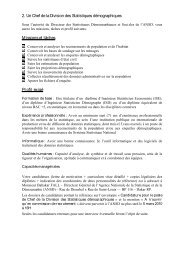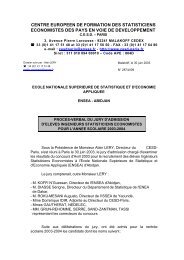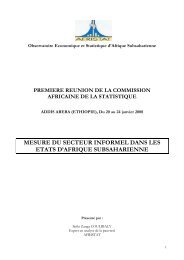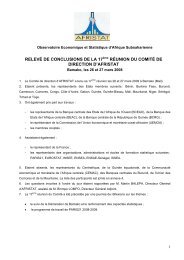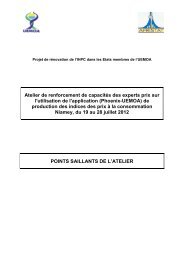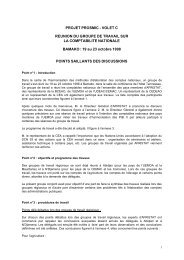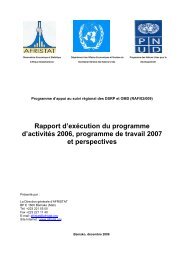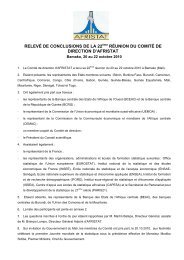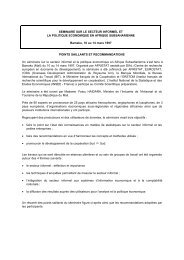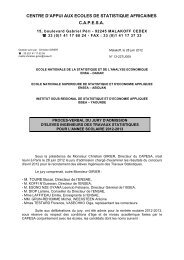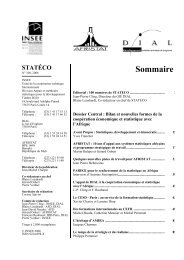Global Purchasing Power Parities and Real Expenditures - Afristat
Global Purchasing Power Parities and Real Expenditures - Afristat
Global Purchasing Power Parities and Real Expenditures - Afristat
Create successful ePaper yourself
Turn your PDF publications into a flip-book with our unique Google optimized e-Paper software.
158 <strong>Global</strong> <strong>Purchasing</strong> <strong>Power</strong> <strong>Parities</strong> <strong>and</strong> <strong>Real</strong> <strong>Expenditures</strong>calculated by first taking all the representative productswithin one country <strong>and</strong> matching them with the productspriced by a second country, no matter whether the productsin the second country were classified as representative.The ratio of prices in the first country to those in the secondis calculated for each of the matched products, <strong>and</strong> ageometric mean is taken of all the price ratios.The process is repeated by matching all representativeproducts in the second country with as many products aspossible from the first country, no matter whether they areclassified as representative in the first country. The priceratios are calculated for all matched products, but this timethe ratios are those between the second country <strong>and</strong> thefirst country. Once again, the geometric mean is calculatedfor the price ratios of all the matched products. The finalbilateral PPP for the basic heading is obtained as the geometricmean of the two geometric means obtained fromthese first two steps. At this point, the PPPs for each basicheading have been calculated as unweighted (more correctly,equally weighted) averages of the prices. No weightsare available below the basic-heading level because, bydefinition, the basic heading is the most detailed level forwhich national accounts expenditures are required forthe ICP (although the distinction between representative<strong>and</strong> nonrepresentative products can be seen as a form ofweighting).Products classified as nonrepresentative by both countriesare excluded from the bilateral price ratio calculations,even if both countries price them; however, prices for theseproducts are not discarded. They can be used in other bilateralcomparisons if some other countries classified them asrepresentative <strong>and</strong> in the EKS procedure to make the PPPstransitive, <strong>and</strong> so they can have some influence on the finalPPP calculations.PPPs for GDP <strong>and</strong> its Major Aggregateswithin a RegionThe EKS methodUsing the EKS method, the aggregation of basic-headingPPPs is undertaken at each level of expenditure up to thelevel of GDP by using the following steps.For each pair of countries, the basic-heading PPPs areweighted, summed, <strong>and</strong> averaged by using the basic-headingexpenditure weights of the first country, <strong>and</strong> thencomputing another weighted average using the secondcountry’s weights. Because the basic-heading expendituresare in each country’s national currency, they are convertedto shares for the weighting process. This step provides twoweighted PPPs at each level of aggregation, each reflectingthe weight distribution of each of the pair of countriesbeing compared. The geometric mean of these two PPPsgives a single PPP between the two countries.The outcome of this process is a matrix of PPPs for eachpair of countries, for each aggregate for which PPPs wererequired, up to the level of GDP. Each matrix consistedof nontransitive PPPs, which were then made transitive byapplying the EKS method. This was done to obtain transitivePPPs that remain as close as possible to the nontransitivePPPs calculated in the initial step.The result is that the real final expenditures are notadditive to higher aggregate levels or to GDP. However, theEKS method avoids the Gerschenkron effect (describedin the next section), which occurs when additive indexingmethods are used. EKS PPPs <strong>and</strong> real final expendituresbased on them are better suited for comparisons acrosscountries. Results from the GK method (described below)are better suited for the analysis of price <strong>and</strong> volume structuresacross countries (for example, real food expendituresas a percentage of the GDP).The transitive EKS PPPs were used as deflators to convertaggregates expressed in national currency into volumesexpressed in a common currency. It is important to notethat because the volumes are not additive, it is not possibleto obtain volumes for any aggregates for which PPPs havenot been calculated directly through the above process.The Geary-Khamis (GK) <strong>and</strong> the Iklé MethodsThe GK method was used to derive aggregate PPPs in previousrounds of the ICP before 1993. Conceptually, theGK method calculates volumes in a numeraire currencyby valuing the quantities in each country using a commonvector of average prices. The price vector has to be as typicalas possible of the region as a whole, <strong>and</strong> so a quantityweightedaverage of the prices for the entire region wouldbe the ideal price vector. To obtain this price vector, pricesin national currency have to be converted to a numerairecurrency using the PPPs. Therefore, average common prices<strong>and</strong> PPPs are interdependent variables in the GK linear



